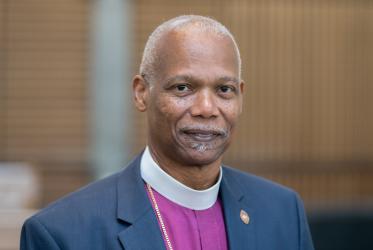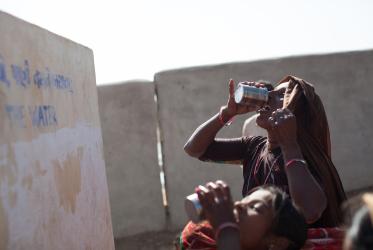By Rev. Audra Hudson Stone and Jacob Stone, USA*
Text:
Matthew 27: 45-46; 50-51 (Common English Bible)
From noon until three in the afternoon the whole earth was dark. At about three Jesus cried out with a loud shout, “Eli, Eli, lama sabachthani,” which means, “My God, my God, why have you left me?”… Again Jesus cried out with a loud shout. Then he died.
Look, the curtain of the sanctuary was torn in two from top to bottom. The earth shook, the rocks split…
Reflection:
For most of earth’s history, natural disasters have been just that—natural. The land shows the scars of ancient earthquakes and the ripples of ancient floods. But in recent centuries, since the advent of the industrial revolution, these landscape and life-changing events have become increasingly unnatural.
Human-driven global temperature rise, habitat destruction, and resource exploitation have, together, contributed to more devastating disasters and extreme weather events.
Water-related disasters, in particular, have intensified from human activity. Since the 1980s, hurricane strength, intensification, and incidence have increased each year. In the southern United States, the two costliest tropical cyclones on record have occurred in the last 20 years. And, in our local context of Michigan, increased precipitation patterns and extreme storms, have made extreme flooding a more frequent phenomenon.
While water is indeed life, we are also witnessing the power of water to cause destruction. The earth is responding to the harm humans have inflicted.
The Gospel of Matthew reminds us that this response is not new. Like the floods and storms of our contemporary moment, the earth shook and the sky darkened when humans dealt death to Jesus. The land had a physical response to the harm wrought by those greedy for power and control.
Jesus, like many frontline communities in the climate crisis, was a victim of empire—a system that prioritizes the few over the many. His vision of justice and mercy, and the priority he placed on the marginalized, was a threat to this prevailing order. Jesus’ death was an attempt to silence a new, more equitable power structure. He was killed to maintain the greed, power, and control of the status quo.
When Jesus cried out for a final time on the cross, the earth responded in kind. It cried too for the continued death-dealing of empire—for the continued harm its patterns of injustice and greed would cause. The rocks split, the sky turned black, and the earth shook in grief and in protest.
Lent is the time in the life of the church that calls us to intentional self-reflection, confession, and repentance. Now, especially, we should not look away from holy stories like these, that remind us of the consequences of greed and an outsized desire for power and control. Now, especially, we must pay attention to the cries of the earth and the cries of the marginalized, who are disproportionately impacted by climate crisis.
But we should not forget the end of this story. We must remember that death is not the end for Jesus, or us. On Easter morning, we remember that God’s love, justice, and mercy prevail. Resurrection signals the reality that healing and wholeness are possible for the community of creation.
And in his resurrected body, Jesus invites us to be a part of it. Jesus, in the words of Wendell Berry, invites us to “practice resurrection,” actively bringing about justice, mercy, and new life in the midst of harm and death.
Signs of resurrection are already among us. In 2020, in our home of central Michigan, a period of heavy rainfall led to the failure of two dams, causing a major flooding event that temporarily displaced 10,000 people. The landscapes of our rivers and lakes were dramatically altered. One hundred fifty homes were destroyed and damages exceeded $200 million.
But this disaster did not go without response. In the following days, weeks, months, and years, thousands of people mobilized to support and uplift the community reeling from this disaster. In our United Methodist Church, meals, money, and prayers were sent, along with disaster response teams who gathered to do the long work of recovery. Houses were repaired and rebuilt. Debris was removed and lives were reassembled. The flooding left indelible scars on the land and community, but healing began with collective action and the work of practicing resurrection.
In this moment of climate crisis, where we witness life-giving water become an agent of life-altering destruction, we must take Jesus’ invitation to resurrection. Our earth is crying out, responding to the ways our actions and collective greed deal death to the most marginalized among us. But we remember that death does not have the final word. Repentance and transformation are possible. We must practice resurrection.
Questions:
Where have you experienced the earth crying out in your context? How are you mourning with the earth?
Where in your community can you practice resurrection, helping to respond to emerging climate-related disasters and needs?
Actions:
Visit a place in your community that has experienced environmental injustice or harm. Lament and discern how God is calling you to the work of healing.
Connect with or support a local disaster response team.
Resources:
United Methodist Committee on Relief (UMCOR)
*Rev. Audra Hudson Stone and Jacob Stone are co-conveners of the Environmental Justice Taskforce of the Michigan Conference of the United Methodist Church. They live in Mount Pleasant, Michigan, United States. They are alumni of the 2023 World Council of Churches Eco-School for Europe and North America. Audra and Jacob are married to each other and together work with young adults, among others, on ecological issues.
Colbert Angela, “A Force of Nature: Hurricanes in a Changing Climate,” NASA, NASA’s Jet Propulsion Laboratory, June 1, 2022, Accessed January 19, 2024, https://climate.nasa.gov/news/3184/a-force-of-nature-hurricanes-in-a-ch…
“Costliest U.S. Tropical Cyclones,” National Oceanic and Atmospheric Administration National Centers for Environmental Information and National Hurricane Center, January 9, 2024, Accessed January 19, 2024, https://www.ncei.noaa.gov/access/billions/dcmi.pdf
“New infrastructure strategy meets climate change head-on,” State of Michigan Department of the Environment, Great Lakes, and Energy, September 14, 2023, Accessed January 19, 2024, https://www.michigan.gov/egle/newsroom/mi-environment/2023/09/14/new-in….
Berry Wendell, “Manifesto: The Mad Farmer Liberation Front” from The Country of Marriage, (San Diego: Harcourt Brace Jovanovich, Inc., 1973), https://ag.arizona.edu/~steidl/Liberation
Flesher John, “Mid-Michigan dams failures that displaced thousands was 'foreseeable and preventable',” Fox 2 Detroit, May 5, 2022, Accessed January 19, 2024, https://www.fox2detroit.com/news/mid-michigan-dams-failures-that-displa…




